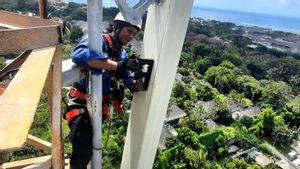
Digital assets including Non-Fungible Tokens or commonly called NFTs have been so popular in recent years. Top Hollywood celebrities and other leading figures also bought NFTs. This condition makes the price of NFT soar significantly.
On the other hand, the level of fraud has also increased by taking advantage of the popularity of the NFT. The negative impact, not a few people see NFT as a form of investment that is at risk due to potential fraud. One of the latest cases of fraud is the emergence of the NFT Mutant Ape Planet project which clearly uses the name of the popular NFT project Mutant Ape Yacht Club (MAYC).
MAYC is a well-known Bored Ape Yacht Club (BAYC) partner product. Both MAYC and BAYC are Yuga Labs' NFT projects. However, fraudsters have taken advantage of the popularity of MAYC and BAYC using similar names, Mutant Ape Planet.
When NFT Mutant Ape Planet began to be bought by NFT collectors, the developer of the project took away investors or collectors' funds. The action is called arug pull. Mutant Ape Planet became an NFT rugby pull project.
Use of Machine Learning
Fortunately, the digital asset industry is fighting back against the scam by introducing Machine Learning (ML)-based technology that can be a game changer for NFT verification.
NFT fraudsters use a number of techniques to scam buyers, brands, artists, and collectors. Most common includes phishing, pump-and-dump scams, fake persona fraud and NFT marketplaces, and fake NFTs that are openly promoted through social media.
A number of digital asset industry players are starting to work together to solve this problem. They combine ML and strong incentives to create a safer environment for both collectors and creators of NFT.
Machine Learning Detection of NFT Fraud
Para pelaku di industri aset digital kerap menggebarkan slogan DYOR yang merupakan akronis dari Do Your Own Research atau lakukan riset sendiri. DYOR biasanya dilakukan seorang investor sebelum membeli kripto atau NFT. Ini ditujukan untuk melakukan penelitian terkait aset digital yang diinginkan sebelum transaksi.
Even so, the fact is that most people who are interested in NFT do not know how to research token or NFT originality. So they don't know whether crypto A or NFT B is fake or a real project.
According to a TheCryptoBasic report, new solutions using Machine Learning have allowed the creation of algorithms trained using NFT transaction data historically, so they can find fake NFTs.
Machine Learning's use to identify scams in other industries, such as financial services, insurance, and gaming, has been well documented, and the same techniques that have been tried and tested can also be applied to blockchains.
The ML algorithm provides a more effective and efficient way to detect fraud thanks to their ability to handle large amounts of data. In this way, ML can detect suspicious trading patterns much faster than humans can do.
Benefits of Machine Learning Use in Blockchain
Another benefit of the ML model is more accurate. Because this machine can process training data in large volumes and continues to train itself, ML becomes more accurate from time to time. This model is also more flexible, because it is able to understand datasets in a way that humans can never do.
Perhaps the main advantage of Machine Learning-based fraud detection is its cost and scalability. Such a system is highly measurable and does not age. In contrast, this system becomes better at predicting fraud over time as the algorithm consumes more data.
Examples of Machine Learning-Based NFT Fraud Detection
Recently, a number of NFT fraud detection devices have emerged that use Machine Learning technology, called WatchDog. It has the same goal of helping collectors identify real NFT scam projects or NFT projects.
WatchDog uses algorithms to identify NFT duplicates and trademark violations. It takes advantage of a powerful computer vision model that allows it to find duplicates, even when images or text have been changed. Whenever a Watchdog finds fraudulent activity, it can notify intellectual property rights holders and suggest ways to protect the IP.
The Watchdog devices include AI machines that monitor blockchains like Ethereum in real-time to detect suspicious activity, plus notification services that work with a number of social media that are often used by crypto or NFT communities such as Discord, Twitter, Telegram, and email.
WatchDog will warn intellectual property rights holders against potential fraud. It can also provide detailed reports on NFT fraud.
Then there is also an NFT digital art fraud detection platform, called Djelapan. This platform can monitor NFTs from various networks (multi-chains) and is specially designed to look for fake NFTs.
Djein mengindeks data NFT dari sejumlah blockchain terkemuka, seperti Ethereum, Solana, dan Flow. Kemudian, Djelapan akan men scan aktivitas NFT baru dalam jaringan tersebut. Djelis akan mengumpulkan berbagai data NFT secara masif yang ditujukan untuk mendeteksi kapan pemalsaan NFT tersebut dibuat.
This is a new platform for detecting fake NFTs that use AI and ML. This detection platform is CheckNFT.io which can be used to analyze NFT collections, detect scam activity and tokens, and minimize risks.
Fighting Against Fraud and Scam in NFT
The emergence of Machine Learning-based NFT fraud detection devices has had a positive impact on the digital asset industry. Detection of the scam can also be accessed widely, as is Wakweli, the NFT certification platform.
Wakweli is a platform that uses Proof of Democracy (PoD) consensus algorithms. Wakweli's own name is taken from my own language which means 'to be honest'. Wakwei is designed for the digital asset community in proving the validity of NFT.
How it works is quite simple. Anyone, such as the maker of NFT, can ask for a certificate to validate NFT by risking (staking) the WAKU token. The protocol uses a human certification giver, who also staked the WAKU, to check the authenticity of the NFT and issue certificates, gets results from their stakes to do so.
Then, the wider Wakweli community is free to challenge the validity of any certificate by risking the WAKU token and providing evidence showing that the certified NFT is fake. The availability of various ML-based tools must ensure that both the Certifier and the Transversator can find all the evidence they need to support their claims.
Wakweli is a powerful protocol that incentives all players to act honestly, and as this becomes wider, and hopefully integrated with a leading NFT marketplace, fraudulent incidents should become much more rare.
In recent years, digital asset industry players have been battling increasing fraud. Digital assets, both cryptocurrencies and NFTs, both use an unlimited potential blockchain technology. On the other hand, there must be a fraud detection platform to increase investor confidence in digital assets against scams, frauds, phishing, and other illegal acts.
The English, Chinese, Japanese, Arabic, and French versions are automatically generated by the AI. So there may still be inaccuracies in translating, please always see Indonesian as our main language. (system supported by DigitalSiber.id)








